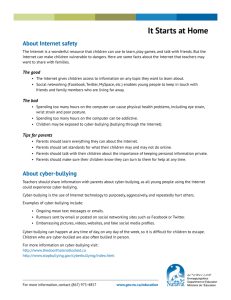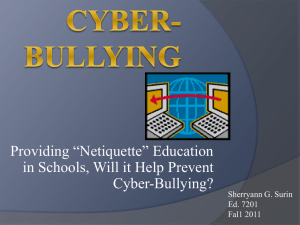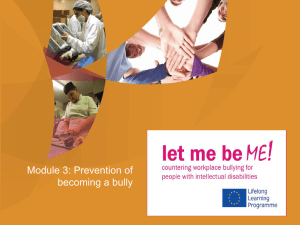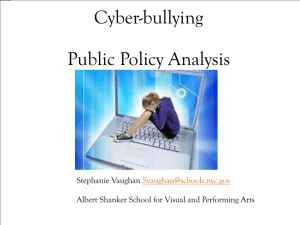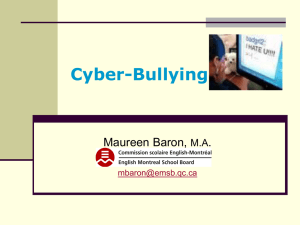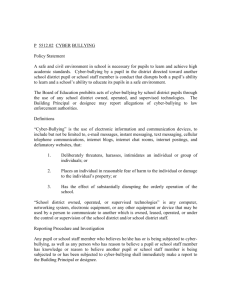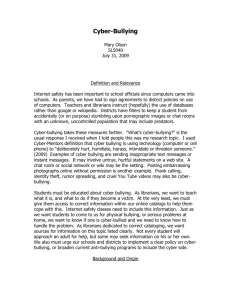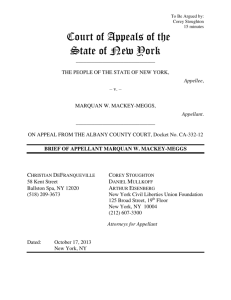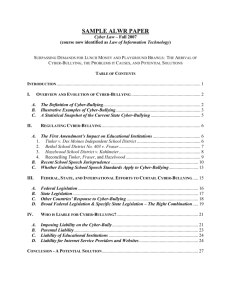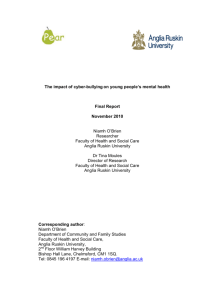6-A Cyber Bullying 7th-12th (VIRTUS
advertisement
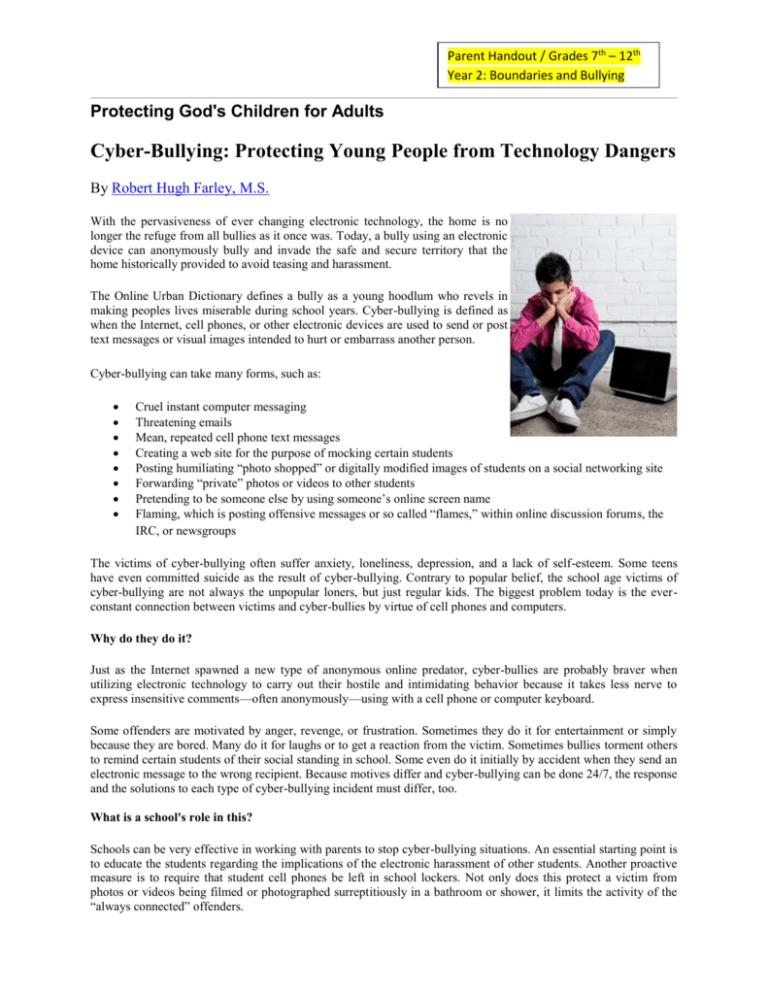
Parent Handout / Grades 7th – 12th Year 2: Boundaries and Bullying Protecting God's Children for Adults Cyber-Bullying: Protecting Young People from Technology Dangers By Robert Hugh Farley, M.S. With the pervasiveness of ever changing electronic technology, the home is no longer the refuge from all bullies as it once was. Today, a bully using an electronic device can anonymously bully and invade the safe and secure territory that the home historically provided to avoid teasing and harassment. The Online Urban Dictionary defines a bully as a young hoodlum who revels in making peoples lives miserable during school years. Cyber-bullying is defined as when the Internet, cell phones, or other electronic devices are used to send or post text messages or visual images intended to hurt or embarrass another person. Cyber-bullying can take many forms, such as: Cruel instant computer messaging Threatening emails Mean, repeated cell phone text messages Creating a web site for the purpose of mocking certain students Posting humiliating “photo shopped” or digitally modified images of students on a social networking site Forwarding “private” photos or videos to other students Pretending to be someone else by using someone’s online screen name Flaming, which is posting offensive messages or so called “flames,” within online discussion forums, the IRC, or newsgroups The victims of cyber-bullying often suffer anxiety, loneliness, depression, and a lack of self-esteem. Some teens have even committed suicide as the result of cyber-bullying. Contrary to popular belief, the school age victims of cyber-bullying are not always the unpopular loners, but just regular kids. The biggest problem today is the everconstant connection between victims and cyber-bullies by virtue of cell phones and computers. Why do they do it? Just as the Internet spawned a new type of anonymous online predator, cyber-bullies are probably braver when utilizing electronic technology to carry out their hostile and intimidating behavior because it takes less nerve to express insensitive comments—often anonymously—using with a cell phone or computer keyboard. Some offenders are motivated by anger, revenge, or frustration. Sometimes they do it for entertainment or simply because they are bored. Many do it for laughs or to get a reaction from the victim. Sometimes bullies torment others to remind certain students of their social standing in school. Some even do it initially by accident when they send an electronic message to the wrong recipient. Because motives differ and cyber-bullying can be done 24/7, the response and the solutions to each type of cyber-bullying incident must differ, too. What is a school's role in this? Schools can be very effective in working with parents to stop cyber-bullying situations. An essential starting point is to educate the students regarding the implications of the electronic harassment of other students. Another proactive measure is to require that student cell phones be left in school lockers. Not only does this protect a victim from photos or videos being filmed or photographed surreptitiously in a bathroom or shower, it limits the activity of the “always connected” offenders. The best school cyber-bullying intervention model is threefold: School-wide Interventions—A survey of cyber-bullying problems at the school, increased supervision, school-wide assemblies, and teacher in-service training to raise the awareness of children and school staff regarding cyber-bullying. Classroom-level Interventions—The establishment of classroom rules against cyber-bullying, regular class meetings to discuss bullying at school, and meetings with all parents. Individual-level Interventions—Discussions with students identified as cyber-bullies and the victims of cyber-bullying. When the school intervenes with a cyber-bully and his or her parents, the initial discussion should include: Explaining what cyber-bullying is and why it is not acceptable. Talking with the student about the impact of bullying others. Trying to get them to understand what it is like for the person being bullied. Clearly explaining the school rules on cyber-bullying and the consequences for breaking them. Discussing what the student thinks might help them to stop bullying in the future. Increasing the Internet or electronic communication supervision of the student—NO school Internet access and NO cell phone on school property. Some schools get involved in disciplining a student for cyber-bullying incidents that take place off school property and outside of school hours. The schools have been accused of exceeding their authority or violating a student's right to free speech. While it is important to consult with legal experts on these possible claims, it is prudent for the school to include a provision to the school's “student policy” reserving the right to discipline a student for any type of cyber-bullying situations on or off school property. In order to develop a case against a cyber-bully, the school disciplinarian must retain all evidence of the cyberbullying. The school file should include computer screen captures, message logs, photos or any other evidence that will demonstrate the seriousness of the behavior and its impact on the victim and the school. This file is especially important if the school intends to formally punish a student with suspension or expulsion. The school may also enlist the support of local law enforcement by notifying a School Resource Officer (SRO) or the Juvenile Officer. This is especially important when it involves a threat to the safety of a student or a staff member. What can you do? A caring adult should always refrain from the knee jerk reaction of immediately banning a victim’s access to instant messaging, e-mail, social networking sites, a cell phone, or the Internet. This strategy neither addresses the underlying conflict, nor does it eliminate current or future instances of cyber-bullying victimization. It also punishes the victim and not the offender. It may also close the open lines of communication that a parent has with their child. A potential victim of electronic technology abuse cannot be vulnerable to emails that are never opened. Talk with your children and encourage them to be cautious opening any emails unless they are familiar with the sender. If your child receives an email or text message that is hurtful or from a cyber-bully, tell them to NEVER respond to it. Responding to a cyber-bully frequently only causes the bullying to escalate. Instead, the victim should save the email, text, or message and then tell a parent or a trusted adult what happened. Internet Service providers can often block cyber-bullies. If the school has educated their students regarding cyber-bullying, hopefully the victim of cyber-bullying will feel comfortable turning to his or her school authorities to quash the cyber-bullying. Finally, if a child has been threatened with harm, the police should be notified immediately. 284052 -02-
